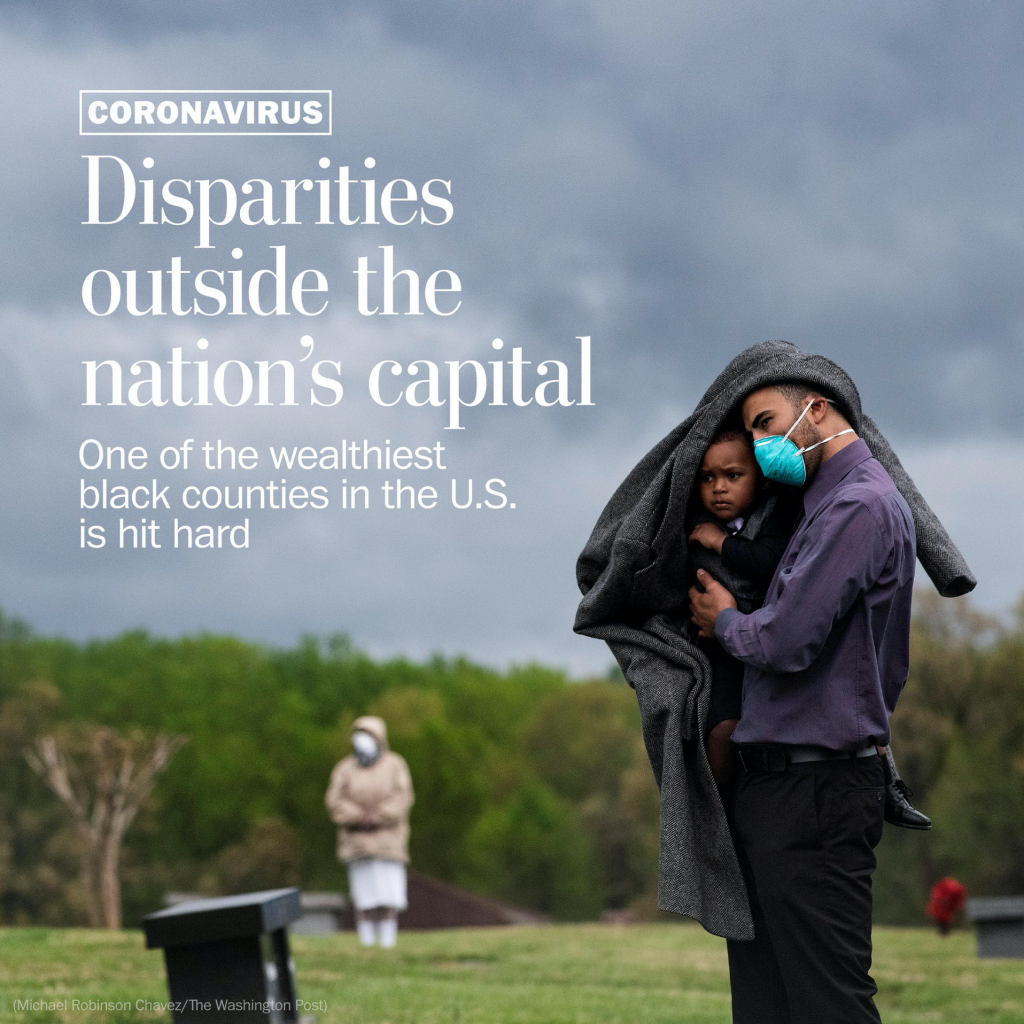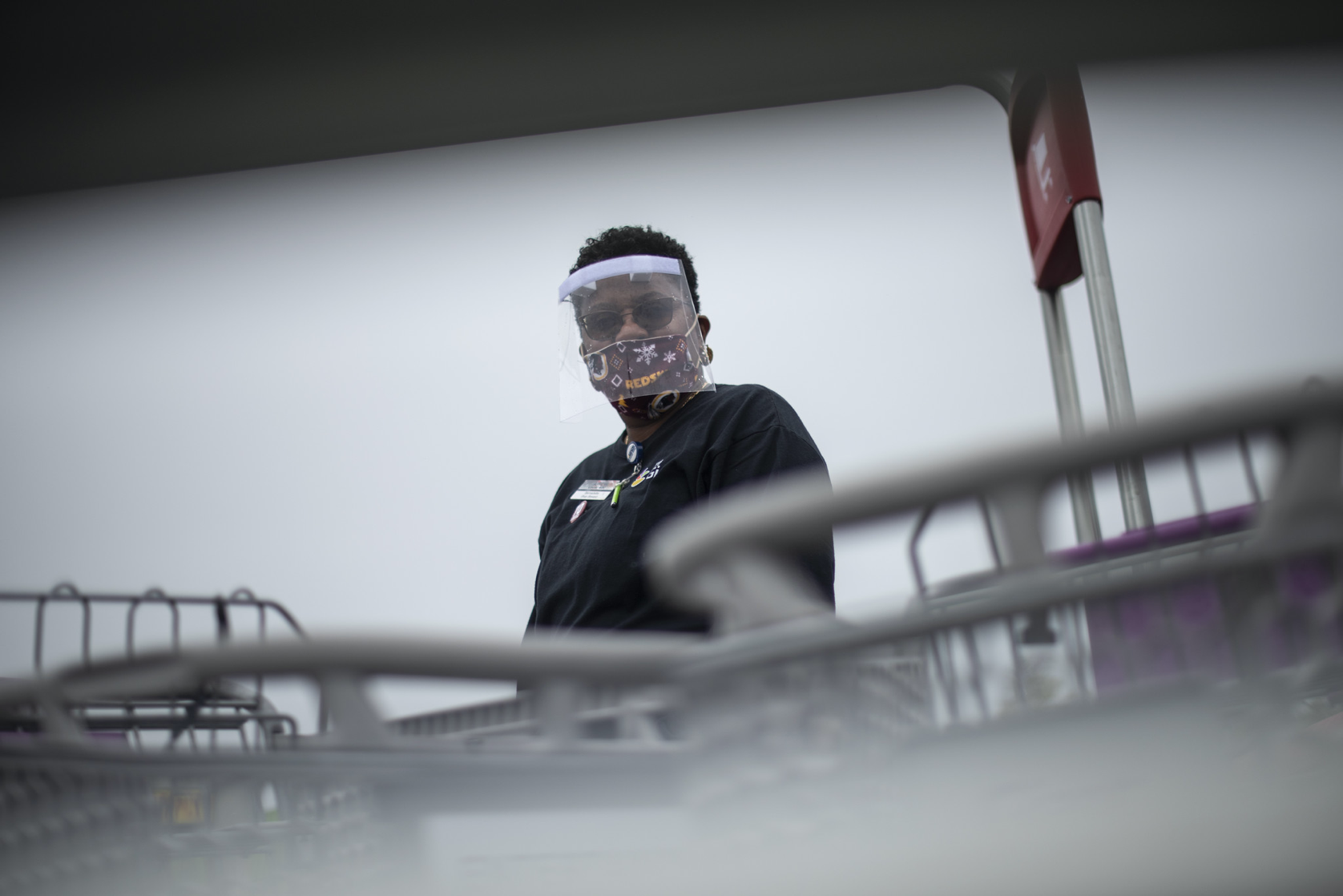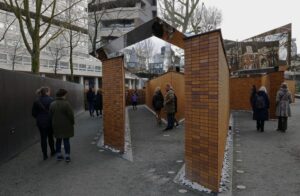
The intensive care unit at Inova Alexandria Hospital has empty beds, and doctors are prepared for a rush of coronavirus patients that has yet to hit the largely white suburb.
A dozen miles away at Adventist HealthCare Fort Washington Hospital Center, the ICU is full, and employees treat coronavirus patients in medical tents in the parking lot. Paramedics across Prince George’s County are summoned daily to help people struggling to breathe, and funeral home directors are searching for more places to store bodies.
Prince George’s, one of the nation’s wealthiest majority-black counties, has reported the most coronavirus infections and some of the highest death tolls in the Washington region. In the hardest-hit neighborhoods, African American and Latino residents make up more than 70 percent of households. The grim statistics mirror data showing black Americans are more likely than white Americans to be infected with the novel coronavirus and more likely to die of it.
Officials say the pandemic has hit the county of 900,000 especially hard because many residents are front-line workers exposed daily to the virus, and Prince Georgians disproportionately suffer from underlying health conditions that make the virus more deadly.
“His comment to me was, ‘I am the only pharmacist,’ ” said Bowie resident Nicole Boynes, whose husband, Sean, had asthma but kept working at a pharmacy he helped found in Greenbelt. Sean Boynes, a former Air Force captain, died of covid-19, the disease the virus causes, on April 2. He was 46.
Nearly 14 percent of adults in Prince George’s have diabetes, according to county health statistics, 36 percent are obese, and 64 percent of the county’s Medicare beneficiaries suffer from hypertension — rates above national and statewide averages. There are fewer hospital beds and primary care doctors than in neighboring jurisdictions, which means residents are less likely to treat medical problems early. The county also spends less on public health efforts than its wealthier neighbors.
The 174 county residents who had died of covid-19 as of Sunday, according to The Washington Post’s tracker, include educators, a maintenance worker, a prominent artist and a pastor. One of the youngest victims was Leilani Jordan, 27, who had cognitive disabilities and worked at the Giant supermarket in Largo.
As the number of cases continues to rise, officials are promising to put more money toward public health, even as the prolonged economic shutdown decimates government budgets. They are determined to improve wellness and find ways to bring doctors and nurses to the communities they say have too long been ignored.
“It’s served as a magnifying glass for challenges we knew we had,” said County Executive Angela D. Alsobrooks (D). “We know that when this is over, we can’t return to business as usual.”
Death transcends class
Maryland’s first coronavirus death, announced March 18, was a Prince George’s man in his 60s with underlying health conditions. The deaths that followed have been people from poor neighborhoods inside the Capital Beltway and wealthy subdivisions outside of it.
A Washington Post analysis found that among the Zip codes with the highest per capita infection rates is 20769, which includes Glenn Dale and has a median household income of $148,800. But there is also 20712, which includes Mt. Rainier, on the border with the District, and has a median household income of $54,800.
Of the deaths in Prince George’s for which the victim’s race or ethnicity was reported, 130 were African American, 15 were Latino, and 19 were white, according to county data.
Jordan, the supermarket worker, lived in Upper Marlboro. Her mother, Zenobia Shepherd, warned her about the risks of the pandemic, but she said Jordan probably did not fully understand.
“She said, ‘Mommy, I’m going to work because no one else is going to help the senior citizens get their groceries,’ ” Shepherd said. “She only stopped going to work when she could no longer breathe.”
Shepherd said her daughter’s death made her more aware of the disparities between white and black communities. Recently, she tried to buy respiratory masks in her local pharmacy; there weren’t any. When she drove across the river to Alexandria, she had no trouble finding them.
She knows that people in her county have higher rates of diabetes and heart disease than others in the region. But she also has grown angry about black people dying across the country after not receiving proper care, including a man in Detroit who died in his home after being turned away from three emergency rooms.
“It’s not right; it’s not right,” Shepherd said. “I’m not going to allow underlying conditions be an excuse for how the black community is being treated in certain communities.”
Supermarket employees across Prince George’s mourned Jordan’s death, said Bernadette Christian, a cashier at the Giant in Camp Springs, Md. Then they kept working, and worrying. She said employees have been dealt blow after blow: Angry shoppers snapping at them, fear about exposing their families, then the death of their colleague.
But Christian, 55, has not missed a day of work and does not plan to.
“People have got to eat,” she said. “You’ve got to eat. You cannot not go to work.”
A strained system
The influx of coronavirus patients has inundated Prince George’s hospitals at times, forcing some patients to be transferred to facilities outside the county.
To add more beds, the state reopened the shuttered Laurel Regional Hospital, which had been downsized to a walk-in medical center in late 2018, and is adding beds at University of Maryland Prince George’s Hospital Center in Cheverly and Fort Washington Medical Center. A testing site was launched at FedEx Field.
Because of underlying health problems, many coronavirus patients in Prince George’s arrive at the emergency room very sick, said Joseph Wright, interim chief executive at Capital Region Health, which oversees the Prince George’s Hospital Center in Cheverly.
The hospital’s case fatality rate is about 7.2 percent, Wright said, and the rate of patients who test positive is about 34 percent — double the rate at the 12 other hospitals in the University of Maryland Medical System.
Stephen B. Thomas, who has studied health disparities in Prince George’s as head of the Maryland Center for Health Equity at the University of Maryland, said racial disparities in health statistics are not limited to covid-19.
A black woman with a college degree is more likely to have her infant die before her first birthday than a white mother without a high school education, Thomas said, and black Americans often get, at age 45 or 50, the chronic illnesses that white Americans get at 65 or 70.
Part of the reason, he said, is that health care tends to be less available in minority communities. And there is sometimes distrust in those communities of medical providers, who have historically responded differently to black and white patients.
“It is a function of how society treats you — whether you need to go to the hospital, or the ICU or need a ventilator,” Thomas said.
Patients often require acute care when they arrive at Fort Washington Medical Center with covid-19, said hospital President Eunmee Shim. The intensive care unit has been full for weeks, and doctors are now treating covid-19 patients in massive medical-surgical tents.
Joe Jenkins, who owns a funeral home in Landover, had received nearly 500 calls for funerals as of early April, an unprecedented pace that puts him well ahead of the 1,346 funerals he conducted over the course of last year. He has purchased another refrigeration unit, nearly doubling his capacity to store bodies.
“It’s a trying time,” Jenkins said.
Under an emergency order by Gov. Larry Hogan (R), funerals are limited to 10 mourners or fewer.
Those who have lost loved ones to covid-19 are offered only direct burials and cremations. Jenkins decided not to allow viewings, which eliminates the need to embalm bodies, because “the CDC or no one else knows what happens to the virus once someone dies.”
Get our Coronavirus Updates newsletter
Receive the most important pandemic developments in your inbox every day. All stories linked in the newsletter are free to access.
Paramedic Jason Rush, who is based at a fire station in College Park, said his crew has treated multiple coronavirus patients who cannot stop coughing. Others do not cough at all, he said, but struggle to breathe.
What they all have in common are dangerously low blood oxygen levels.
Rush said he wears gloves, wraparound eye protection, an N95 mask covered by a surgical mask and a gown. He worries about exposing his 9-year-old son to the virus but never thinks twice about answering the calls.
“We are going to do the job regardless,” he said.
Alsobrooks, who grew up in the county, said she personally has received calls for help from constituents who are worried they have the coronavirus. She called an ambulance for one earlier this month who told her he couldn’t breathe.
Transition and struggle
The history of Prince George’s makes the story unfolding there distinct from those in highly segregated cities like Detroit, Chicago and New Orleans, Wright said. Prince George’s was a mostly white, working-class suburb through the 1970s.
Starting in the 1980s, it attracted more middle-income and wealthy black professionals, creating a rare example of a county that grew more affluent as white residents moved out.
Despite the concentration of wealth and education in the county, there remain pockets of poverty, and officials have struggled to consistently attract the kind of development — including grocery stores and restaurants — that residents want.
Swaths of the county are considered food deserts by the federal government. Dialysis centers are common in its strip malls. About 11 percent of residents do not have insurance, higher than state and local averages. There are 477 primary care physicians in Prince George’s, fewer than half the 1,420 in neighboring, more affluent and whiter Montgomery County, which has about 20 percent more residents.
“The reasons are structural, and they are historical,” Wright said. “The county did not get here overnight.”
County tax revenue has been limited by a law capping property taxes that first passed in 1978. Prince George’s County Council member Dannielle M. Glaros (D-District 3) said health and social services have been underfunded since the 1990s, when the county’s budget was slashed in a brief recession.
The 2008 housing crisis devastated Prince George’s, wiping out a generation of wealth for residents and leading to a foreclosure crisis and budget implosion that took years to claw back from.
More than a decade later, Prince George’s invests far less of its own money in health and human services than its neighbors, putting $38.94 per capita toward those services in 2018, compared with $224.25 in Montgomery County, $90.54 in Anne Arundel County and $109.37 in Howard County, according to a council budget briefing.
Even with grant funding, the county lags behind those other jurisdictions, with Montgomery still spending more than twice as much as Prince George’s.
Glaros said that reliance on grants, which are typically short-term and come with restrictions, hurts programming and staff recruitment and retention. She is pushing for a big increase in county funding in next year’s budget, despite the anticipated loss of revenue from the prolonged shutdown.
“People can laugh if they want, but I’m going to make these big requests,” Glaros said. “Because the need is great, and we need to prioritize it.”
Moving forward
Before the overwhelmed hospitals, the spike in unemployment and deaths, progress was being made in Prince George’s, according to Alsobrooks, who took office 17 months ago after eight years as the county prosecutor.
A long-delayed regional hospital is set to open in Largo next year, potentially drawing primary care and other physicians to the county.
Alsobrooks has been pushing for grocery stores, and there is money in her proposed 2021 budget for a salad bar in every elementary school.
Alsobrooks had requested a 15 percent increase for the county’s health department budget but said that amount will probably have to be dramatically cut because of lost revenue.
She and other officials know that an impending recession will bring challenges for everyone and that the county will again suffer. But they hope the pandemic also demands attention to — and accounting for — disparities they have long known existed.
County Council member Derrick Leon Davis (D-District 6) said Prince George’s has a responsibility to be a leader.
“We are a majority-minority county with means,” he said. “If not us, then who?”
Rep. Anthony G. Brown (D-Md.), whose congressional district includes Prince George’s, would like to bring back an initiative he launched as lieutenant governor in 2013, which offered tax breaks and other incentives for primary care doctors and social services to locate in underserved areas.
A study by Johns Hopkins Bloomberg School of Public Health showed that in the zones where the program was implemented, there were 18,562 fewer hospital stays than in similar areas that did not see the same investments.
The program saved about $108 million over four years, Brown said, including millions in Prince George’s County. He is working on a bill in Congress to create something similar nationwide.
Thomas, the professor, said officials have not always been keen to make such substantial investments in the lives of African Americans — or even acknowledge the extent to which disparities exist.
“But now is the time to take the color blinds off,” he said.
The highly contagious coronavirus has shown in the grimmest terms how the health of one community is connected to that of another.
Thomas said he hopes that new reality changes the calculus about who deserves funding — if not for moral reasons, then for practical ones.
“It’s about enlightened self-interest,” he said. “If the virus returns in Temple Hills or Capitol Heights, it won’t be long before it spreads.”
Rachel is a metro reporter covering local politics. She has previously contributed to The Raleigh News and Observer, CNN Politics and USA Today.
Ovetta Wiggins covers Maryland state politics in Annapolis. She came to The Washington Post in 2003 and previously worked at the Philadelphia Inquirer and the Bergen Record in New Jersey.
John D. Harden is a metro data reporter for The Washington Post. He joined The Post after four years working for the Houston Chronicle as a data and breaking news reporter.




